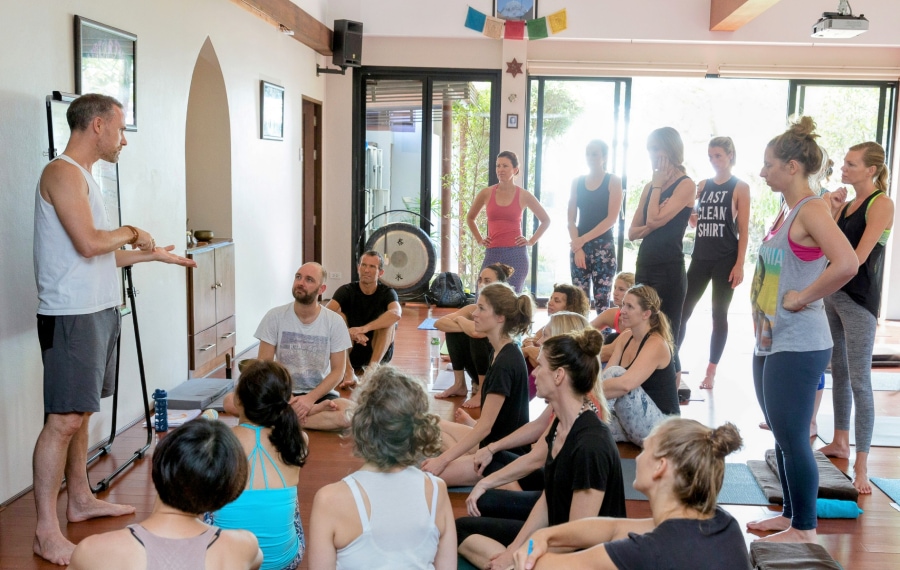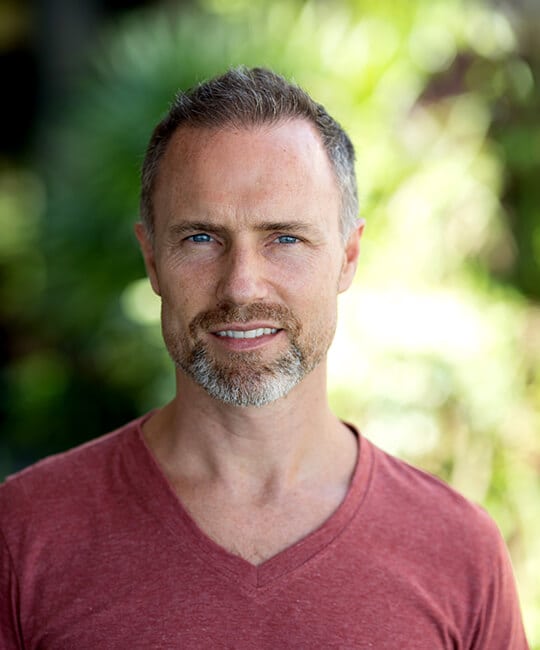ATT-300 Course 6: Breath, Yoga & Science: Modern Science on the Breath and Yoga Methods & practice of Prānāyāma
Offered next in 2025
Dr. Paul Dallaghan
Overview:
A course for interested students of yoga and those already teaching to expand one’s knowledge and understanding of how yoga practice actually ‘works’. Go in to greater detail on the human biology of the Yoga Process, how physical activity in yoga is differentiated from exercise, and learn the detail of the anatomy of the breathing apparatus complex and physiology of breathing. There will also be updates and insights into scientific findings related to breath and yoga practice in the scientific and cultural realms. Plus, continue to develop and deepen prānāyāma, kriyas, and āsana practice, with ongoing Q&A relating to breath practice.
This course fulfills 100-hours of the Advanced TT 300-hours certification and is also a required course within the 600-hour Prānāyāma Teacher Training (PTT) certification.
Course Detail:
This course draws on up-to-date anatomical, physiological and recent scientific materials that detail how the body, breath, and even mind ‘work’ as applicable to an expanded and improved understanding of yoga practice, its effect, and why to continue in practice.
Though breath or energy as life force has been dealt with in early to pre-modern yogic texts this understanding of physiology and metabolism was incomplete until the modern scientific era was able to look into the body in miniscule detail. Though the second wave 1,500-year window of yoga developed a psycho-physical yoga method and practice where the human physiological element was a key element, it is only recently we can offer much greater detail to that.
The last two decades alone, since the year 2000, have revealed incredible advances and understanding of the human body and brain. For instance, it is only within this time period that control of the breath by the brain, a respiratory central pattern generator in the brainstem, was clearly identified and explained. It also took a global pandemic to shift the world’s attention to the value of the breath and how valuable it is in daily life, both well-being and therapy.
The scientific aspect of Paul’s doctoral research went into great detail on physiological, metabolic, and psychological aspects of human behavior. This material and the knowledge of yoga’s original teachings allowed for a detailed explanation of physical activity in yoga versus in exercise. Further, how the breath works and the detail of the abdomen as divided between a ‘Stress Response Zone’ and the ‘Hatha Zone’ have also been developed in detail. This can then be applied to breath practices termed under either prānāyāma or kumbhaka, training āsanas, and the cleansing kriya practices.
The course will use original research materials that include written sections that collate scientific
Science of Breath & Physical Activity in Yoga Teaching Topics:
Reading materials will be given each morning with the aim that you read it prior to class. This will facilitate a more effective discussion in class which is optimal for learning and comprehension to increase.
- A short overview of human biology related to the Yoga Process
- Defining features of hatha in brief & distinguishing principles of āsana
- Revisiting the Translational Model of Yoga (as related to Classical and Hatha in courses 4+5)
- Assessment of physical activity in yoga (yoga-PA)
- How yoga-PA is differentiated from exercise-PA (e-PA)
- Tabulation of the differentiating features of yoga-PA and e-PA
- Understanding autonomic imbalance and the stress response
- The Autonomic Nervous System anatomy and physiology with a focus on the vagus nerve
- The abdomen and pelvis anatomy and physiology with a focus on the lower abdomen
- Exercise-PA Physiology and Inferred Hypothetical Yoga-PA Mechanisms
- Respiration and its anatomy and physiology identified across five broad components
- Regular breath practice, psycho-physiological well-being, and emotional resilience
- Yoga-PA as one tangible aspect of the Yoga Process in empirical research
- How and why one practices is crucial to what one practices under yoga-PA
- The paradox of rising health issues and sedentariness alongside a surge in PA interest
- Any scientific updates from recent findings & recommendations within this body of work
Teaching Approach:
 The material is delivered through presentations and class discussions of this insightful and highly-researched written material, given to you before class to read in greater or lesser detail. Topics can then be explored and explained and further unpacked based on questions and insights coming from the class.
The material is delivered through presentations and class discussions of this insightful and highly-researched written material, given to you before class to read in greater or lesser detail. Topics can then be explored and explained and further unpacked based on questions and insights coming from the class.
These courses (4, 5, and 6) are also breath-to-prānāyāma intensives, both in practice and in explanation and discussion of the techniques. It is important to note each module addresses certain aspects of breath and prānāyāma and therefore learning of this deep area occurs over a few years of both class presentation and focused practice. However, each of these courses make time for daily ongoing Q&A relating to prānāyāma practice. The more scientific understanding as relates to prānāyāma is what is covered in this course 6 more specifically.
This in-depth study of the formation and understanding of yoga is supported by well-researched written materials that you receive as part of this course. Due to the richness and depth of the course it is possible not every topic is covered within the time allowed. This allows for a range of original material to be presented within this curriculum each time the course is offered on alternating years.
A Typical Day:
Morning practice begins with a short silent sitting followed by an āsana-for-prānāyāma routine. This leads us into sitting practice of meditation techniques. We continue with the practice of some kriyas and build the breathwork-to-prānāyāma practice, based on the classical method outlined in Psycho-Physical (Hatha-Rāja) Yoga, as taught by Centered Yoga at Samahita. The routine to this point is 3-hours of practice in body, breath, and inner focus. For those that want more and enjoy an active āsana practice we continue with Engaged Dynamic Āsana, alternating between guided class with instruction by the teacher and self-practice, so that the collection of āsanas can be developed in your own time. The afternoon program will be divided between seated energetic center focused meditation, philosophy presentation and discussion, and a day-closing prānāyāma practice session.
Daily Schedule
The program begins at 5pm on the first day of the training with a group welcome. Check out is by 12pm on your last day. The schedule is subject to change at the discretion of the teacher.
| 5:45 am | Beach sunrise silent watch on outdoor beach sala (optional way to start the day) |
| 6:15 – 6:30 am | PULSE /REST: Silent sitting (or savāsana) during pulse analysis (8 students/day) |
| 6:30 am | OFFICIAL MORNING START |
| 6:30– 7:40 am | KRIYAS /ĀSANA /SIT: Opening kriyas followed by a focused āsana routine that supports prānāyāma and sitting practice that leads into sitting for Centered meditative internal practices into silence. |
| 7:40 – 9:10 am | PRĀNĀYĀMA: Focused Detail of Breath, Kriyas and Prānāyāma methods |
| 9:10 – 10:40 am Or when complete (from 20 to 90 mins) |
DYNAMIC ĀSANA: GUIDED EDA: Engaged Dynamic Asana – Guided sequence options or SELF – Teacher Assisted Self-Practice or Restorative Body Breath Practice |
| 10:00 am – 1:30 pm | BRUNCH BUFFET |
| 2.30 – 2:50 pm | Snack and refreshment
Paul available for 1-to-1 chats where necessary, about 10 min’s each, 2-3 a day WORKOUT: Bonus Fun Cycle or Core workout class (20 min’s max) or at 6 pm |
| 3:00 – 3:45 pm | SITTING: Breath regulation to Pranava Japa to silent sitting |
| 3:45 | LECTURE with DISCUSSION: following the day’s topic |
| Open time | Q&A: your questions and comments on both practice and philosophy/science |
| Open to 6 / 6:30 pm | PRĀNĀYĀMA: Prānāyāma practice into energy center work & silent sitting |
| 6.00 – 8.00 pm | Complimentary herbal steam room available – great after class with a swim and a beach walk, just before …… DINNER BUFFET |
| 8.00 pm | Your own private time |
Teacher
Dr. Paul Dallaghan
Dr. Paul D. has devoted the last three decades to developing expertise in the field of breath-mind-body lifestyle. He has received a Ph.D. from one of the leading universities in the US, covering both the tradition and science of yoga and breath practices. He has been uniquely acknowledged in the Yoga tradition by the title of “Master Yogi-Prānācharya (expert in breath)”. He has been a dedicated teacher for 25 years and a pioneering entrepreneur establishing the first sustainably-based yoga-breath-meditation retreat center in Asia, Samahita Retreat, in 2003. Paul’s continuous effort is to help people improve their mental and physical health, as a teacher, researcher, and presenter. He is an extremely natural and gifted speaker and has taught and spoken at events all over the world.
See his full bio.
Rates
Rates are in US Dollars, are per person, and are fully inclusive of your chosen room, all buffet meals, use of full facilities, and all training and practices for the duration of the program dates.
| NEW “Inhale” Beachfront Rooms |
Beachfront Private | $4,114 |
| Beachview Private | $3,494 | |
| Beach Private | $3,234 | |
| “Exhale” Gardenview Rooms | Garden Private | $2,714 |
| Garden Semi-Private | $2,454 | |
| Garden Shared Loft | $2,194 |
If you plan to book two or more ATT courses in a row, please email reservations at [email protected] to book your room for the full length of your stay.
Want to extend your stay?
Want to extend your stay?
| Length of Training | Rate per Extra Night for YogaCoreCycle | ||
| Private Room | Semi-Private Room | Shared Two-Bedroom Loft | |
| 2 weeks | $118 / night | $98 / night | $78 / night |
| 4 weeks | $108 / night | $88 / night | $68 / night |
| 6 weeks | $98 / night | $78 / night | $58 / night |
*These discounts also apply to an extended stay on a wellness program.
- Offer valid to a max of 7 nights
- Subject to room availability
- No refunds, changes, or transfers – based on original program booking of 2, 4 or 6 weeks
Confirm your rate and book all extended stays directly with reservations [email protected]
Need to bring a friend, partner or family member?
Subject to availability, we have Friends & Family rates for any registered Samahita Retreat guest’s partner, family member or friend, who is not interested in participating in any of the programs but will stay in a room and board capacity. Shared guest rooms, food, and the facilities are open to them. If they prefer to engage in the selection of yoga, breath, meditation, and fitness classes every day then a separate booking under YogaCoreCycle is advised
Enjoy Our All Inclusive Facilities
Facilities
Samahita RetreatFood
Samahita RetreatGuest Rooms
Samahita RetreatThe Heart of Samahita is found in its impressive mix of facilities that provide the space for your experience, as well as through the food where tasty and healthy merge powerfully, and in our quality mix of guest rooms, where you can stay in the highest of standards right at the beach or find rooms to suit all budgets from beach to garden. And when here you can also paddle board, kayak and snorkel, amongst other activities. Feel free to take a tour and find out where Samahita is located.

